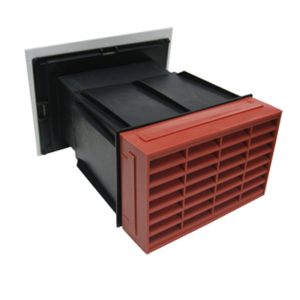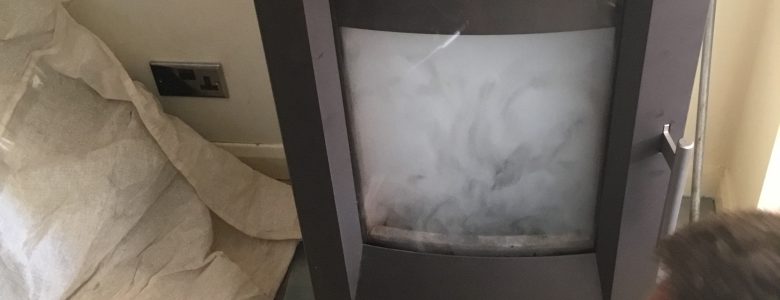Hello and welcome to my blog today.
There are several distinct types of smoking back into the room of the appliance, there are strong telltale signs of the type and what may be causing them, I will break them down into customer descriptions or symptoms.
- Symptoms: The chimney smokes back into the room after some time, the smoke seems to gulp or pulse as if pouring wine out a full bottle.

The above type of smoking back typically describes a lack of ventilation in the room where the appliance is sited. As warm heated air rises up the flue to the outside the room gradually depressurises, as the room pressure lowers without the advent of additional air from a vent or window then the vacuum of the room can cause air to be drawn down the chimney in a gulping fashion, exacty as when you pour wine. If there was a small hole in the base of the wine bottle then it would flow freely as the pressure out would be equalled by the pressure in. There is a very simple test which is as easy as opening an outside window to the room when this backsmoking occurs. The 4pa test can also give accurate measurements of available combustion air without all the smoke and fumes. The remedy for this problem is usually as simple as adding an air vent.
- Symptoms: The chimney immediately or after a few moments smokes back when I try to light a fire and it doesn’t get any better. The whole room fills with smoke.
The above symptom most commonly refers to a total or near complete blockage. Possible causes can be; closed dampers, caps in or on chimney pots, heavy soot build up, epanded creosote from a chimney fire, birdsnests, fallen debris and a myriad of other potential things. After first checking for the obvious with a torch and mirror it might be time to break out the chimney camera and take a peek inside.
- Symptoms: Occasional smoking back where the smoke can intermittently change direction often when the wind blows.
This type of smoking back is often referred to as a wind induced down draught, it often occurs when the wind is coming from the direction of a taller building or tree, the wind has to travel a longer distance over the surface when compared to the air above causing a lower pressure on one side that’s the other just like an airplane wing. This results in air being directed down the flue. I know of several fixes for this phenomenon, the best of which is cutting down the offending tree or demolishing said building however this is not always practical. In some conditions a rotary cowlings can work to solve this problem H pots are excellent with this type of down draught but are expensive and heavy.
- Symptoms: Whenever the wind blows towards X object which is close to and taller than the chimney the smoke changes direction and pushes into the room.
This statement often relates to a positive pressure down draught, When the wind pushes Towards and hits a physical object such as a loft conversion, tree, building or even hillside a hig pressure bubble or area is formed. If the chimney termination is within this high pressure one then air will be pumped down the chimney. Fixing this is the easiest to say but often the hardest to achieve, you simply extend the chimney out of the high pressure zone. As this is sometimes unachievable a mechanical chimney fan might be the only other option.
- At around x o’clock the chimney seems to start working in reverse
You would typically hear this from the landlord of a public house, hotel or restaurant and X o’clock often corresponds to the time when the kitchen opens. This phenomenon is often directly attributable to the exhaust fans in the kitchen area which are very powerful and are able to depressurise the entire building very quickly. An easy fix for this is to intstall a larger diameter intake fan than the extract thus ensuring that there is always positive pressure within the building fabric.
- The smoke is lazy and slow and there might be occasional leakage into the room
A lazy updraught if often the biggest problem to diagnose, it can be caused by a myriad of things the most obvious being that the chimney requires Sweeping and is partially blocked. Other causes may be, poor design, partial blockage, a cold chimney, a hot day, and damaged components or a leaking flue you know how hard it is to suck milkshake through a straw with a split in it right? If you suspect a leak you must advise a pressure test to confirm wether or not the chimney requires relining.
I hope you have found this blog useful and that the knowledge helps you better serve your clients as it has us
please like share and comment
kindest regards
Daniel Hodgson
Master Chimney sweep







Michael Waters
Hi Daniel,
I run a small sweeping business here in my little community. Daylesford, Victoria, Australia.
I’m learning a lot from your blogs. I’ve been sweeping for nearly 3 yrs, but all of my knowledge so far is self taught. I’d love to do course in sweeping but they don’t exist here in Australia. Hopefully next time I get to the mother country I’ll have time to fit a course in. My wife and I were there in June for a quick stay, but not enough time.
Please keep the knowledge sharing coming, it’s much appreciated.
Cheers Mick
Daniel
I hope you enjoy my blogs. I make them as useful as I possibly can.
Thanks for your interest
John
Interesting and well written post. Thanks for making the effort to share the knowledge .
Daniel
Thanks your most welcome
Spencer Corbett
Very useful information I’m loving the blogs .. thanks Safe sweeping and keep our customers safe and warm …
Stuart
Very interesting blog as I’m new to the business every bit of information is welcome
Thatch Advice Centre
Useful information, thanks
Liam k
Great advice
Lee Oliver
Well written. Excellent advice mate
Daniel
Thank you